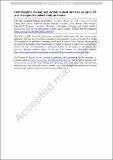Antiresorptive therapy and dental implant survival: an up to 20-year retrospective cohort study in women
Author(s)
Cheng, Yu-Chi; Ewers, Rolf; Morgan, Katherine; Hirayama, Muneki; Murcko, Laura; Morgan, John; Bergamo, Edmara T. P.; Bonfante, Estevam A.; ... Show more Show less
Download784_2022_4609_ReferencePDF.pdf (2.113Mb)
Publisher Policy
Publisher Policy
Article is made available in accordance with the publisher's policy and may be subject to US copyright law. Please refer to the publisher's site for terms of use.
Terms of use
Metadata
Show full item recordAbstract
Abstract
Objectives
To investigate the effects of antiresorptive treatment on the survival of plateau-root form dental implants.
Materials and methods
Patients undergoing antiresorptive therapy via oral or intravenous administration as well as patients not undergoing antiresorptive therapy and healthy control patients were included in this retrospective cohort study. In total, 1472 implants placed in 631 postmenopausal patients (M: 66.42 ± 9.10 years old), who were followed for a period of up to 20 years (8.78 ± 5.68 years). Kaplan–Meier survival analysis was performed, and univariate and multivariate Cox regression, clustered by each patient, was used to evaluate and study factors affecting the survival of their implants.
Results
Implants placed in patients undergoing oral antiresorptive treatment presented significantly higher survival rates, than implants placed in the osteoporosis/osteopenia control cohort (p value < 0.001), and similar survival rates, when compared to healthy controls (p value = 0.03). Additionally, clustered univariate and multivariate Cox regression analysis also revealed higher implant survival when oral antiresorptive drugs (p value = 0.01 and 0.007, respectively) were used, and lower implant survival in the presence of untreated osteoporosis/osteopenia (p value = 0.002 and 0.005, respectively). Overall, the 20-year implant survival in osteoporotic patients undergoing antiresorptive therapy was 94%. For the failed implants, newly replaced implants in patients under antiresorptive treatment presented a 10-year survival of 89%.
Conclusions
Long-term plateau-root form implant survival in osteoporotic patients taking oral antiresorptives was similar to a healthy population and significantly higher than the untreated controls.
Clinical relevance
These results suggest that plateau-root form implants provide a robust solution for treating tooth loss in patients, who are undergoing antiresorptive therapy.
Date issued
2022-08-24Department
Massachusetts Institute of Technology. Department of BiologyPublisher
Springer Berlin Heidelberg
Citation
Cheng, Yu-Chi, Ewers, Rolf, Morgan, Katherine, Hirayama, Muneki, Murcko, Laura et al. 2022. "Antiresorptive therapy and dental implant survival: an up to 20-year retrospective cohort study in women."
Version: Author's final manuscript